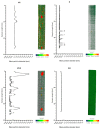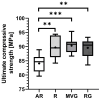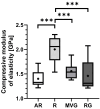Does the Addition of Low-Dose Antibiotics Compromise the Mechanical Properties of Polymethylmethacrylate (PMMA)?
- PMID: 39204597
- PMCID: PMC11359730
- DOI: 10.3390/polym16162378
Does the Addition of Low-Dose Antibiotics Compromise the Mechanical Properties of Polymethylmethacrylate (PMMA)?
Abstract
The increasing numbers of total joint replacements and related implant-associated infections demand solutions, which can provide a high-dose local delivery of antibiotics. Antibiotic-loaded bone cement (ALBC) is an accepted treatment method for infected joint arthroplasties. The mechanical properties of low-dose gentamicin-loaded bone cement (BC) in medium- and high-viscosity versions were compared to unloaded BC using a vacuum mixing system. As an additional control group, manual mixed unloaded BC was used. In a uniaxial compression test, ultimate compressive strength, compressive yield strength, and compression modulus of elasticity, as well as ultimate and yield strain, were determined according to ISO 5833-2022 guidelines. All groups exceeded the minimum compressive strength (70 MPa) specified in the ISO 5833 guidelines. Both ALBC groups showed a similar ultimate compressive and yield strength to the unloaded BC. The results showed that vacuum mixing increased the compression strength of BC. ALBC showed similar compressive strength to their non-antibiotic counterparts when vacuum mixing was performed. Added low-dose gentamicin acted as a plasticizer on bone cement. From a biomechanical point of view, the usage of gentamicin-based ALBC formulations is viable.
Keywords: antibiotic-loaded bone cement; compression testing; gentamicin; local delivery of antibiotics; mechanical properties; periprosthetic joint infection.
Conflict of interest statement
The authors declare no conflicts of interest.
Figures









Similar articles
-
Evaluation of Different Experience Levels of Orthopaedic Residents Effect on Polymethylmethacrylate (PMMA) Bone Cement Mechanical Properties.Iowa Orthop J. 2015;35:193-8. Iowa Orthop J. 2015. PMID: 26361465 Free PMC article.
-
Gentamicin in bone cement: A potentially more effective prophylactic measure of infectionin joint arthroplasty.Bone Joint Res. 2013 Oct 15;2(10):220-6. doi: 10.1302/2046-3758.210.2000188. Print 2013. Bone Joint Res. 2013. PMID: 24128666 Free PMC article.
-
Antibiotic-loaded bone cement and periprosthetic joint infection.J Long Term Eff Med Implants. 2014;24(2-3):89-97. doi: 10.1615/jlongtermeffmedimplants.2013010238. J Long Term Eff Med Implants. 2014. PMID: 25272207 Review.
-
Elution and Mechanical Strength of Vancomycin-Loaded Bone Cement: In Vitro Study of the Influence of Brand Combination.PLoS One. 2016 Nov 17;11(11):e0166545. doi: 10.1371/journal.pone.0166545. eCollection 2016. PLoS One. 2016. PMID: 27855203 Free PMC article.
-
Comprehensive meta-analysis of antibiotic-impregnated bone cement versus plain bone cement in primary total knee arthroplasty for preventing periprosthetic joint infection.Chin J Traumatol. 2022 Nov;25(6):325-330. doi: 10.1016/j.cjtee.2022.06.001. Epub 2022 Jun 9. Chin J Traumatol. 2022. PMID: 35717367 Free PMC article.
Cited by
-
Different polymethylmethacrylate (PMMA) reinforcement strategies for long bone osteoplasty procedures: a controlled laboratory comparison using the 4-point bending test.BMC Musculoskelet Disord. 2024 Dec 21;25(1):1058. doi: 10.1186/s12891-024-08148-9. BMC Musculoskelet Disord. 2024. PMID: 39709357 Free PMC article.
-
Evaluation and testing of polymethylmetacrylic (PMMA) bone cements with admixed Amphotericin B.J Orthop Surg Res. 2025 Feb 8;20(1):151. doi: 10.1186/s13018-025-05565-x. J Orthop Surg Res. 2025. PMID: 39920816 Free PMC article.
-
CORR Insights®: Does Cement Viscosity Impact Antibiotic Elution and In Vitro Efficacy Against Common Prosthetic Joint Infection Pathogens?Clin Orthop Relat Res. 2025 Mar 1;483(3):498-500. doi: 10.1097/CORR.0000000000003313. Epub 2024 Nov 8. Clin Orthop Relat Res. 2025. PMID: 39513939 No abstract available.
References
LinkOut - more resources
Full Text Sources
Research Materials

